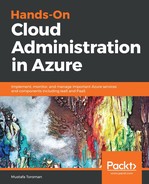Once a subscription is in place, you can start creating resources in order to use them and deploy your application. Choosing what to use and when can be overwhelming in terms of the broad choice Microsoft Azure has to offer. There are different approaches and different architectures we need to consider before even starting.
We have already talked about IaaS, PaaS, and SaaS. An example of Microsoft SaaS is Office 365 and, as a cloud software, it is available under a subscription model. Office 365 even runs in Azure data centers (it was the initial purpose of these data centers along with identity management—we now call this Azure Active Directory), but we will not discuss this product further as it isn't directly connected to Azure subscriptions. Our goal will be to distinguish Microsoft Azure's offerings when it comes to IaaS and PaaS.
IaaS is the first step in migration to the cloud. It's natural for traditional IT professionals to accept this as a first step in the cloud journey. Creating an Azure virtual machine is simple and from a VM level there isn't much difference between a local VM and a cloud VM. You don't have access to hardware or host components, which makes maintenance easier and cheaper. But administering and managing VM in Azure isn't much different form on-premises versions, no matter what host we used locally—Hyper-V, VMWare or something else (Microsoft Azure uses a modified version of Hyper-V hosts that are different than the version used on-premises).
You select an image for the operating system, select the size of the VM, and some other parameters. From there forward, you connect to your VM and install features and software as you see fit. You can control access, frameworks, and data for all software installed on your VM; you'll need to pay for it as part of a subscription or provide a valid license of you own. If your create a VM with Windows Server 2016 and SQL Server 2016, you will be charged extra for both licenses.
Creating a PaaS resource is even simpler than IaaS. It's easier to administer and manage as well. But, on the other hand, control is no longer completely in your hands. You can edit some key features that are predefined to have different values or to be turned on and off. But, some things are default and you are no longer able to edit them. All licenses are included in the price of resources by default.
Let's consider a simple scenario where you have a web application running on IIS in the frontend and a database on SQL Server in the backend.
For IaaS, you'll need to create two virtual machines, a web server, and a database server. In order to host your application, you'll need to set up IIS on a web server that will be running Windows Server 2016. A database server can be a VM with SQL Server 2016 running on Windows Server 2016. By now, added to our computing prices, we have two licenses for Windows Server and one license for SQL Server (price also varies in the version of SQL Server if we choose web, standard, or enterprise edition). Once we have installed and configured IIS, we need to create firewall and network security group rules that will allow us to access our application over the internet. We need to set up communication between the web server and database server and create similar rules in order to allow communication between our application and database. We already have our hands full enabling a simple scenario with IaaS.
For IaaS, we will set up the app service plan in order to host our web application and Azure SQL database for the backend. All licenses are already configured and we don't have to do anything else in terms of configuration. The process is much simpler and easier.
But on the other hand, PaaS doesn't always allow us to have everything we need to run our applications. If we need to use an older version of some framework, PaaS will not work. PaaS already has a preconfigured set of frameworks that you can use but you can't install anything additionally. In the case that you have some features for the database that are not supported in Azure SQL or compatibility issues, you need to use SQL Server in VM.
Overall, PaaS is usually cheaper and needs less attention than IaaS, but IaaS gives better control and better legacy support.
Service offerings are growing by the day and every few weeks we have new services and new features in Microsoft Azure. A couple of services that we mentioned are only examples for a simple scenario. IaaS does give us control as to what is going to be on our VM and offers better combinations compared to a single resource, but the PaaS list doesn't stop there. For Azure PaaS, we can create an app service, content delivery network, Azure SQL database, traffic manager, service bus, Azure functions, Azure CosmosDB, Azure storage, and Redis cache just to name a few.
Azure data platform has over 50 different services that are PaaS. The same goes for other platforms such as web, media, compute, and so on. Choosing the right service can be beneficial both when we look at the solution from a financial perspective and a performance perspective. We need to consider if some service has some limitation that will make us use another service just to cover that limit. And there could be another service that will cover both aspects and there will be no need to use an additional service. Limitations can cause performance issues if we don't look at all aspects and try to anticipate all possible scenarios. Luckily, with Azure, we are not stuck with a single solution, even if we see that we have made a mistake and the service we chose doesn't really cover our needs—we can always scale out or switch to another service completely.
